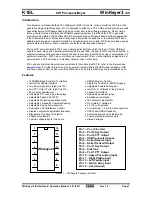
Instruction Manual
D102602X012
657NS Actuator
November 2012
13
diameter rod into a hole in the spring adjusting screw (key 12). Using the rod, turn the spring adjusting screw away
from the diaphragm (key 2) to relieve all compression in the spring (key 6).
5. Loosen the hex nuts (key 16), and remove the stem connector cap screws and stem connector halves (key 26). If
necessary, the actuator may be removed from the valve body by removing the valve bonnet stud bolt hex nuts.
6. Remove the spring adjusting screw (key 12), the spring seat guide (key 36), the lower spring seat (key 11), and the
spring seat bearing and race (keys 41 and 42).
7. Remove the actuator spring (key 6) and the spring adjusting screw locknut (key 91).
8. Unbolt the diaphragm casing cap screws and hex nuts (keys 22 and 23), and lift the upper diaphragm casing (key 1)
and attached casing flange (key 51) with seal bushing (key 46) straight up until clear of the actuator stem (key 10).
9. Remove the snap ring (key 47) and slide the seal bushing (key 46) out of the casing flange (key 51). Inspect the seal
bushing for wear, and replace if necessary. Remove the seal bushing O-rings (keys 44 and 45). Separate the casing
flange (key 51) from the upper diaphragm casing (key 1) by removing the cap screws (key 8). Remove the gasket
(key 52) from the upper diaphragm casing (key 1).
10. Slide or lift the actuator stem (key 10) with the attached diaphragm plates and diaphragm (key 48, 4, and 1) out of
the actuator.
11. To aid in unscrewing the hex nuts (key 49), attach the stem connector assembly (key 26) onto the actuator stem
and grip the stem connector in a vise. This procedure will help secure the actuator stem and help prevent damage.
12. Unscrew the hex nuts (key 49), and slide them, the diaphragm plate (key 4), diaphragm (key 2), and upper
diaphragm plate (key 48) off the actuator stem.
13. Remove the cap screws (key 8) that secure the lower diaphragm casing (key 5) to the actuator yoke (key 9), and
remove the lower casing.
Assembly
Size 40, 45, and 70 Actuators
Key number references are shown in figure 2 for size 40 and 45 actuators and in figure 3 for size 70 actuators.
1. Apply lithium grease to the threads and spring seat bearing surface of the adjusting screw. Thread the adjusting
screw (key 12) into the yoke (key 9).
2. Use the cap screws (key 8) to attach the lower diaphragm casing (key 5) to the yoke. Tighten the cap screws to 41
N
S
m (30 lbf
S
ft) for sizes 40 and 45 and 102 N
S
m (75 lbf
S
ft) for the size 70.
3. Insert the lower spring seat (key 11) and spring (key 6) into the yoke. Be sure the spring seat fits squarely on the
adjusting screw and that the spring is properly seated in the spring seat.
4. Assemble the actuator stem (key 10) and the diaphragm plate (key 4) with the cap screw and washer (key 3 and 25).
Tighten the cap screw in accordance with table 4. The size 40 actuator does not use a washer.
5. Insert the stem and diaphragm plate as an assembly, making sure that the stem fits inside the adjusting screw and
that the spring fits squarely on the diaphragm plate.
6. Install a new diaphragm (key 2) if one is required. Otherwise, replace the molded diaphragm (key 2) onto the
diaphragm plate so that the molded edge points outward toward the spring (see figures 2 and 3) and the word
Fisher printed on the diaphragm is visible. Line up the holes in the diaphragm's edge with the diaphragm casing cap
screw holes.
Note
When you replace actuator diaphragms in the field, take care to ensure the diaphragm casing cap screws are tightened to the
proper load to prevent leakage, but not crush the material. Perform the following tightening sequence with a manual torque
wrench for size 40, 45, and 70 actuators.






































